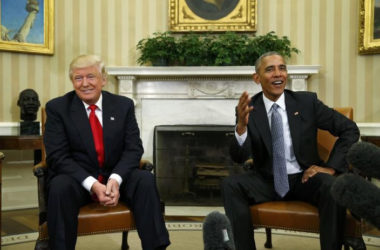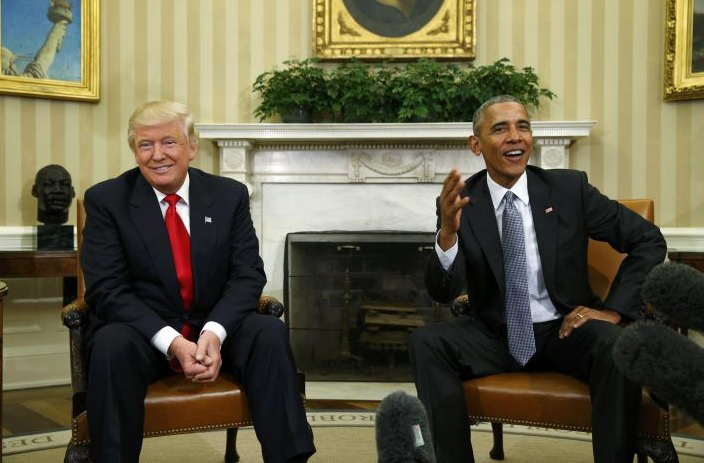WASHINGTON, (Reuters) – U.S. President Barack Obama’s foreign policy legacy rests in part on a foundation of unilateral actions that his successor Donald Trump could reverse with the stroke of a pen.
Due to take office on Jan. 20, Trump, the winner in Tuesday’s election, campaigned at times to dismantle Obama’s nuclear deal with Iran and to reimpose sanctions Obama eased on Cuba. Trump also disagreed with foreign policy decisions that included the way Obama has deployed troops abroad to combat Islamist militant groups.
In his most notable foreign policy achievements, Obama, a Democrat, used executive authorities that offered a convenient legal path around a Republican-controlled Congress committed to blocking his agenda.
The U.S. Constitution gives a president broad executive powers to enact foreign policy. Both Republican and Democratic presidents have sought to exercise those powers by issuing executive orders, presidential memoranda and what are called findings. “He (Obama) relied on executive authority to build a foreign policy legacy,” said Thomas Wright, director of the Project on International Order and Strategy at the Brookings Institution.
“That is all vulnerable to countervailing executive authority by a Trump administration,” Wright said.
Obama had hoped to pass his legacy on to Democrat Hillary Clinton, his former secretary of state, but she lost the presidential election to Trump, a Republican businessman who has never held public office or served in the military.
Often contradicting himself during the campaign, Trump made it difficult to know for sure what policies he would pursue. Major constraints include budget caps, laws he cannot reverse without Congress, and the pressure that will emerge to replace policies he chooses to abandon.
Trump said in an October speech that he would “cancel every unconstitutional executive action, memorandum and order issued by President Obama” on his first day in office, without saying who would determine their constitutionality.
A Trump spokeswoman did not respond to a request for comment yesterday on his latest plans.

EXECUTIVE ORDERS,
ENACTED & RESCINDED
Perhaps nowhere has Obama faced more congressional opposition than in his pursuit of the 2015 deal with Iran, which Republicans and some Democrats said put too few restrictions on Iran’s nuclear program in return for too much sanctions relief. Trump has vowed to dismantle it, although his statements on the deal have been contradictory. A president may tighten and relax economic sanctions by executive order.
“Anything enacted by executive order can be rescinded by executive order,” said Zachary Goldman, a former U.S. Treasury official now at New York University.
Obama drew enough support from Democrats to block a Republican-led resolution rejecting the Iran deal, achieving a political victory but falling short of a consensus. Trump will have the added advantage of working with a U.S. Senate and a House of Representatives controlled by fellow Republicans.
Senate Republican Leader Mitch McConnell said on Wednesday he hoped Trump would “see how much he can undo the unilateral actions the president took all by himself, which would not require us.”
Breaking with longstanding U.S. policy on another issue, Obama restored diplomatic ties with Cuba in 2015. But facing opposition in Congress to lifting a broad economic embargo, especially from Republicans, he used executive actions to ease some U.S. sanctions.
Obama capped his Cuba efforts last month with a sweeping “presidential policy directive,” which also is reversible and sets forth mandates for government engagement, people-to-people exchanges, and greater U.S. business ties.
Trump has taken contradictory positions on whether he supports the embargo or not. Obama’s aides said the easing of restrictions was aimed at securing enough benefits for U.S. businesses and travelers that it would be difficult, if not impossible, for any Republican president to reverse the opening to Cuba.
Trump could roll back Obama’s efforts to create greater transparency about drone strikes. Obama issued an executive order in July requiring annual disclosures about such strikes.
MILITARY POWER
As commander-in-chief, Trump will wield the power to mobilize the U.S. military on short notice and without first seeking approval from Congress.
Obama deployed U.S. troops to Iraq, Syria and Libya to help fight the Islamic State militant group by relying on the authority Congress granted President George W. Bush to battle al Qaeda. That same authority would allow Trump to ramp up U.S. deployments in fights against Islamist militants if he chose to do so.
One former U.S. intelligence official, speaking on condition of anonymity, said the president can approve covert action and needs only to brief relevant leaders in Congress once the operation is under way.
Trump’s powers, however, are limited.
He pledged to expand the Army, grow the Marine Corps, boost the Navy from 276 to 350 ships and submarines, and raise the number of Air Force tactical aircraft from 1,100 to 1,200. For starters, that would require that Congress scrap government spending caps under the Budget Control Act.
Trump’s support for water-boarding, an interrogation technique that simulates drowning, also would meet opposition. Congress last year passed legislation barring the use of waterboarding and other “extreme interrogation techniques” widely considered torture. Obama signed the measure into law last November.

